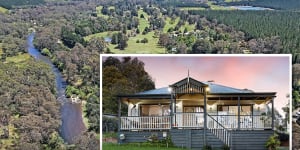The median house price across regional Victoria rose 1.7 per cent in a year to reach $585,000,the latest Domain House Price Report for the December quarter showed. Melbourne’s median house price dropped 5.6 per cent over the same period,albeit to a much higher $1,033,000.

Regional house prices were faring better than prices in Melbourne.Integrity Real Estate
Domain chief of research and economics Dr Nicola Powell said the peak rate of growth in house prices had passed,and the regions appeared to take less of a hit as prices began to stabilise.
“[Regional prices] grew 43.4 per cent from March 2020,” she said. “When you do that direct comparison to the house prices in Melbourne it was 24.1 per cent.
“House prices in Melbourne have fallen 5.6 per cent from their peak,whereas in regional Victoria they’ve fallen 1.7 per cent from the March 2022 peak.”
KPMG regional economist Terry Rawnsley said regional property markets had greater growth than the city due to the increase in demand from tree-changers over the past three years.
“More population growth is coming through. The economy is still more stimulated,” he said.
Given many of these areas were still relatively more affordable than their city counterparts,it was unlikely for house prices to fall back to pre-COVID levels despite the broad housing downturn,he said.
“Regional housing has had a revaluation and hence we’ve got an uplift,” Rawnsley said.
Most of those regions are unlikely to head backwards to pre-COVID prices because of ongoing demand and tight rental vacancy rates,he said.
“The increase in population,the change of demographic,it’s going to hold up more of their post-COVID levels rather than swinging back to their pre-COVID levels.
“What the pandemic has done is a big re-pricing of housing in regional areas. Housing has become more expensive across the board.”
He said an extra 100 or 200 people in some regional communities was enough to shift the dial in their housing markets permanently.
The Hindmarsh,Murrindindi and Gannawarra council areas had the fastest rates of growth over the past 12 months,up 31.2 per cent,30 per cent and 24 per cent respectively.
Prices in Murrindindi,the council which includes Alexandra,Yea and Kinglake,more than doubled over the past five years.

Integrity Real Estate agent William Verhagen said the Murrindindi region had already come off the boil and most property owners could expect a more normal rate of capital growth in the coming 12 months.
“That means we should see stabilisation of the market some time this year,” he said. “We have seen some prices go down in the local area,and it comes down to what sells well and what doesn’t.
“People are pickier than ever.”
The Murrindindi area had benefited from the COVID-induced pivot to working from home,Verhagen said,and its protected status as a low-development area meant less construction and therefore no threat of oversupply.
“It’s a greenbelt area so … they tend to be heavily protected by the zoning,” he said. “I don’t see that changing too much.”
Meanwhile,the Alpine Shire Council – an area which boomed earlier in the pandemic – had the largest yearly decline in prices,with a 9 per cent fall. The median for the December quarter was $710,000,which was 71 per cent more than five years ago.
Dickens Real Estate director Gerard Gray said the tree-change rush had changed the make-up of Bright,the region’s second-largest town,and pushed up prices in nearby Myrtleford.
“If you go back 10 years ago Bright’s biggest portion of sales was going to retirees and all of a sudden,retirees are a smaller part of the market,” he said. “The people who are coming here are active people.
“There’s access to ski fields,tracks for running and the mountain bike trails.”
Powell said regional Victorian prices were now losing momentum.
“We’re likely to see prices pull back but we’re likely to see a softer landing in regional Victoria than we are in Melbourne,” she said.
“It’s quite interesting that the reaction in the regional Victorian market was similar to other capital cities.”